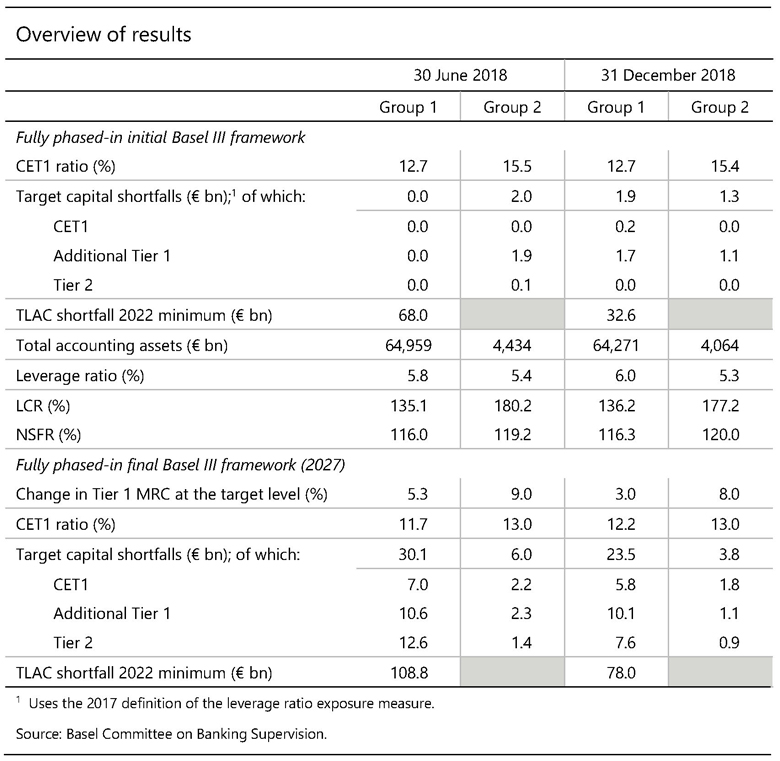Basel III monitoring results based on end-2018 data published by the Basel Committee
- Changes in minimum required capital from fully phased-in final Basel III remain stable for large internationally active banks compared with end-2017, including the recently recalibrated market risk standards
- Liquidity ratios remain stable compared with end-June 2018
The Basel Committee today published the results of its latest Basel III monitoring exercise, based on data as of 31 December 2018. Through a rigorous reporting process, the Committee regularly reviews the implications of the Basel III standards for banks, and has been publishing the results of such exercises since 2012. The report sets out the impact of the Basel III framework that was initially agreed in 2010 as well as the effects of the Committee's December 2017 finalisation of the Basel III reforms. For the first time, it also reflects the finalisation of the market risk framework published in January 2019.
Data are provided for a total of 181 banks, including 105 large internationally active banks. These "Group 1" banks are defined as internationally active banks that have Tier 1 capital of more than €3 billion, and include all 29 institutions that have been designated as global systemically important banks (G-SIBs). The Basel Committee's sample also includes 76 "Group 2" banks (ie banks that have Tier 1 capital of less than €3 billion or are not internationally active).
The final Basel III minimum requirements are expected to be implemented by 1 January 2022 and fully phased in by 1 January 2027. On a fully phased-in basis, the capital shortfalls at the end-December 2018 reporting date are €23.5 billion for Group 1 banks at the target level. These shortfalls are almost 75% smaller than in the end-2015 cumulative QIS exercise, thanks mainly to higher levels of eligible capital. For Group 1 banks, the Tier 1 minimum required capital (MRC) would increase by 3.0% following full phasing-in of the final Basel III standards relative to the initial Basel III standards. This compares with an increase of 3.2% at end-2017.
On average, at end-June 2018, the total change in Tier 1 MRC at the target level was higher at 5.3% for Group 1 banks. This higher increase was largely driven by the higher market risk impact prior to the application of the recalibrated 2019 standard.

The monitoring exercises also collect bank data on Basel III's liquidity requirements.
The weighted average LCR for the Group 1 bank sample was 136% on 31 December 2018, compared with 135% six months earlier. For Group 2 banks, the weighted average LCR remained declined slightly from 180% to 177%. All but two banks in the sample reported an LCR that met or exceeded the final 100% minimum requirement.
Basel III also includes a longer-term structural liquidity standard: the Net Stable Funding Ratio (NSFR). The weighted average NSFR for the Group 1 bank sample remained stable at 116%, while for Group 2 banks the average NSFR increased slightly to 120%. As of December 2018, 94% of the Group 1 banks and 95% of the Group 2 banks in the NSFR sample reported a ratio that met or exceeded 100%, while all banks reported an NSFR at or above 90%.
Note to editors
The results of the monitoring exercise assume that the positions as of 31 December 2018 were subject to the fully phased-in initial or final Basel III standards. That is, they do not take account of the transitional arrangements set out in the Basel III framework. No assumptions were made about bank profitability or behavioural responses, such as changes in bank capital or balance sheet composition. For that reason, the results of the study may not be comparable with industry estimates.
